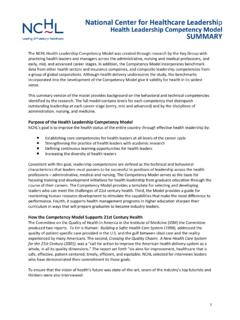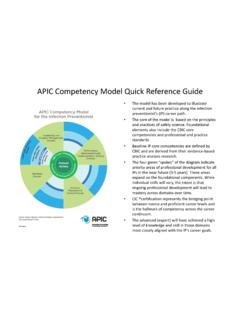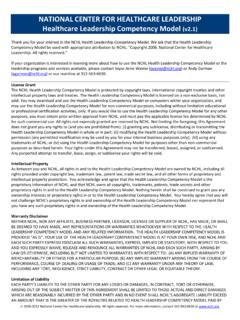Transcription of COMPETENCIES AND COMPETENCY MODELS: …
1 E-MAIL PHONE 310 471-4865 WEB SITE COMPETENCIES AND COMPETENCY MODELS: does ONE SIZE FIT ALL? Patricia K. Zingheim, , Gerald L. Ledford Jr., , and Jay R. Schuster, Article published in ACA Journal, Spring 1996, Volume 5 No. 1, pages 56-65 Although COMPETENCIES are not new, paying for COMPETENCIES is rapidly gathering attention. In many firms, the rate of change is so great that the individual job has ceased to be useful as the "atom" around which organizations and human resources practices are structured. Job-based pay has outlived its usefulness in such companies. Firms are searching for a new logic to pay and a new basis for salary structures that are better aligned with organizational strategies, structures, cultures and other HR practices.
2 At this point, COMPETENCY -based pay is the most promising base pay alternative to job-based pay. The naive observer might expect to find a tremendous variety in the COMPETENCIES that companies are rewarding. The COMPETENCY -based pay approach is new, and there is no obvious set of "best practices" at this point. Moreover, managers are adopting COMPETENCY -based pay to meet organizational needs better, and such needs vary from one organization to the next. The seed for this article is an observation that the authors find paradoxical. While it seems there should be great variety in the COMPETENCIES that are the basis for COMPETENCY -based pay, the authors' experience suggests that COMPETENCY -based pay plans look much alike from one firm to the next. In this article, the authors ask why this appears to be happening and whether it is desirable.
3 BUSINESS STRATEGY AND REWARD SYSTEM DESIGN A strong reason for changing pay processes and systems is to encourage development of behaviors and skills that reflect business strategy and organization design (Lawler 1995). Values, processes and pay structures may vary from organization to organization and influence how pay gets the message across. However, strategic alignment is the goal. Pay systems designed to communicate strong messages of strategy and direction are necessary to generate organizational performance. On the other hand, pay systems that emphasize values such as bureaucracy, entitlement and internal equity may not be practical for organizations that must compete for business and talent (Schuster and Zingheim 1992). Thus, COMPETENCIES may be considered as talent-based interpretations of business needs.
4 This view defines COMPETENCIES as demonstrable characteristics of the person, including knowledge, skills and behaviors, that enable performance (Ledford 1995b). Based on this definition, COMPETENCIES add value by 1996 Patricia K. Zingheim, Gerald L. Ledford Jr. and Jay R. Schuster - 1 - communicating what people must know to help the business succeed. This is imperative during competitive times. Challenged organizations commonly need to get attention for new solutions because existing approaches, while comfortable, no longer add value. If COMPETENCIES and a COMPETENCY model are to support new directions, the source of COMPETENCIES may include the following: Strategy, structure and culture. Organizations need to respond to continuous changes in the business environment and the challenge of seeking competitive advantage.
5 To help implement new strategic direction, people should expect to be made aware of how they can help. Best practice of market leaders. Human resources practices may be emulated from organizations that have enjoyed success realigning people processes and systems to support business change. Successful organizations tend to have experience in interpreting and communicating new human resources directions. Emphasis on strategy may eliminate internal sources of COMPETENCIES from consideration if they sustain the no-longer-functional status quo rather than communicate necessary new directions. THE STRATEGIC DEFINITION OF COMPETENCIES COMPETENCY - and performance-based pay are necessary partners in linking rewards to business strategy and direction. Performance-based pay is needed to encourage the application of acquired COMPETENCIES to generate desired outcomes.
6 COMPETENCIES are most likely to serve as a learning platform for performance. Support for the strategic COMPETENCY definition also comes from interest in becoming a learning organization. Companies hope to outlearn their competitors by making knowledge a tool of advantage (Senge 1990). This is especially true for knowledge-based work that most believe will continue to account for much of needed productivity, quality and other value-added gains (Quinn, et al. 1987). James Collins and Jerry Porras, in their best-selling book Built to Last: Successful Habits of Visionary Companies, tell an interesting story about the competitive advantage of companies with a sustaining core vision. They examine the life histories of 18 "visionary companies," which are companies that have been very successful and influential over a period of decades, along with a set of matched competitors.
7 For example, they contrast Ford Motor Co. with General Motors Corp., General Electric Co. with Westinghouse Electric Corp., Motorola with Zenith Electronics Corp., and Procter & Gamble Co. with Colgate-Palmolive Co. Both the visionary and comparison companies are successful, but long-term performance indicates that the visionary companies are "gold medalists" in their industries while the comparison companies tend to be "silver and bronze medalists." Collins and Porras argue that the development and maintenance of a compelling core ideology distinguish the visionary companies. Figure 1 on page 58 shows examples of the core ideologies. Human resources practices such as selection systems, management and development, communication and goal setting convey and reinforce the firm's core ideology.
8 These practices signal what is most important to learn and do to succeed in the company. Collins and Porras devote little attention to pay systems. However, it is a logical extension of their work to suggest that there should be a direct connection between pay and core ideology in high-performing, visionary companies. Specifically, companies should pay for COMPETENCIES that are aligned with their core ideologies. There is no specific set of core ideologies that apply to all visionary companies, but certain themes are common to them. The authors expect that companies that adopt COMPETENCY -based pay that is in line 1996 Patricia K. Zingheim, Gerald L. Ledford Jr. and Jay R. Schuster - 2 - with their core ideologies would also reward these characteristics.
9 The most prominent principles are innovation, product quality and customer service, individual initiative and growth, integrity, continuous improvement and self-renewal, and technical superiority. Figure 1 SAMPLE CORE IDEOLOGIES OF SELECTED COMPANIES American Express Co.: customer service, reliability, initiative The Boeing Co.: leading edge, pioneers; challenges and risks; product safety and quality; integrity and ethics; aeronautics Citicorp: expansionism; being out front (best, innovative); autonomy and entrepreneurship; meritocracy; aggressiveness and self-confidence General Electric Co.: technology and innovation, balance among stakeholders, responsibility and opportunity, honesty and integrity Hewlett Packard Co.: technical contribution, respect and opportunity for HP people, contribution and responsibility, affordable quality, profit and growth Procter & Gamble Co.
10 : product excellence, self-improvement, honesty and fairness, respect for individual 3M Corp.: innovation, integrity, initiative and personal growth, tolerance for honest mistakes, product quality and reliability, problem solving Wal-Mart Stores Inc.: value to customers; buck conventional wisdom; partnership with employees; passion, commitment, enthusiasm; run lean; pursue high goals Walt Disney Co.: no cynicism; consistency and detail; creativity, dreams, imagination; "magic"; "bring happiness" and "American values" Source: Collins and J. I. Porras, Built to Last: Successful Habits of Visionary Companies, HarperCollins, 1994 OVERVIEW OF COMPETENCY PAY MODELS Compared to the amount of attention COMPETENCY -based pay has attracted, relatively few COMPETENCY pay systems are operational.








